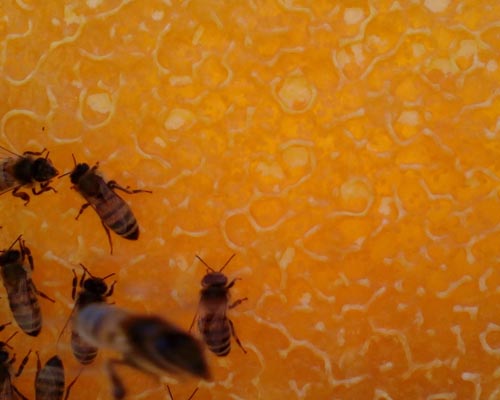OECD TG 245: Honey bee (Apis mellifera L.), Chronic Oral Toxicity test (10-day feeding)
Agriculture provides habitat and forage for pollinating insects such as honey bees.
As well as producing honey and a variety of hive products, honey bees perform the ecosystem service of pollination which allows plants to reproduce, provides the fruits and seeds.The use of plant protection product in agriculture leads to exposure of honey bees to pesticide residues. The need to carry out 10-day chronic oral test on adult honey bees derives from the fact that acute oral and contact toxicity tests not allow to take into account the potential chronic exposure to pesticides in-hive, a very different scenario from the time-limited exposure in the field simulated in acute laboratory test.
Young worker honey bees, less than 2 days old, are exposed to the test substance by food supplied continuously and ad libitum over a period of 10 days to evaluate chronic effects. 2 days before the test starting, brood frames with capped cells are taken from the hive and incubated in climatic chambers until hatching. One day before the test starting, hatched bees are collected from the combs and distributed in the test cages. Bees are acclimatized to test conditions for 1 day. The food consumption is recorded each day by weighing the feeders before and after the administration of 24 hours. Mortality and behavioural anomalies are observed and recorded daily during the test period.
TEST SYSTEM
Honey bee young workers of Apis mellifera L.

STUDY DESIGN
Range finding test includes at least 3 concentrations of the test substance and 1 untreated control, at least 2 replicates for treatment and for the control with 10 bees/replicate.
Limit test is carried out with 1 concentration of the test substance, 1 toxic reference substance and 1 untreated control, 5 replicates for treatment and for the control with 10 bees/replicate.
Dose-response test includes at least 5 concentrations of the test substance, 1 toxic reference substance and 1 untreated control, 3 replicates for treatment and for the control with 10 bees/replicate.
Analytical check
Once during the experimental phase, 1 sample of the lowest concentration and 1 sample of the highest concentration of the stock and the feeding solutions are analyzed to determine the effective concentration of the test substance.
Analyses are carried out using a method validated according to SANCO/3029/99 rev. 4 guidance documents.
ENDPOINTS
Mortality: LCx/LDDx and NOEC/NOEDD and LOEC/LOEDD after 10 days of treatment.
Study includes GLP management and reporting.
REFERENCES AND GUIDELINES
OECD Guideline fo Testing of Chemicals, No. 245 (09th October 2017) – Honey bee (Apis mellifera L.), chronic oral toxicity test (10-day feeding)
SANCO/3029/99 rev. 4 (11/07/2000) – Residues: guidance for generating and reporting methods of analysis in support of pre-registration data requirements for Annex II (Part A, section 4) and Annex III (Part A, section 5) of Directive 91/414.
Study finder
Scientific Contact
Sabrina Mantilacci
E-mail: mantilacci@biotecnologiebt.it
Phone: +39 075 895 0045 – Ext. 268
Business Contact
Katy Lazzari
E-mail: klazzari@biotecnologiebt.it
Phone: +39 075 895 0045 – Ext. 246
Need more info? Send us a message
Fill in the form with the required information (*).
Our team will be happy to provide all the necessary support with regard to your request.


 English
English Italian
Italian